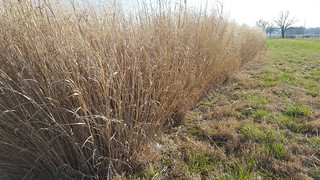Switchgrass may offer potential for native grass in pastures
Switchgrass may offer potential for native grass in pastures
Fast Facts:
- Switchgrass considered the “super native warm-season grass
- Known for vigorous growth, high biomass yield, frugal use of soil nutrients
- Offers advantages to growers who want native grass in their fields
(349 words)
PHOTO available for download: https://flic.kr/p/FXe3Mn
FAYETTEVILLE, Ark. — The unrealized promise of a biomass industry aside, switchgrass offers many advantages for land owners thinking about adding a native grass to their pastures, said Dirk Philipp, forage researcher and associate professor of animal science for the University of Arkansas System Division of Agriculture.

Switchgrass is adapted to a wide range of environmental conditions, Philipp said. Once established, it persists very well and out-competes other grasses and broadleaf plants.
“Switchgrass is considered the ‘super native warm-season grass’ based on its morphology, vigorous growth, high biomass yield, and frugality with soil nutrients,” Philipp said.
It tolerates wet areas, Philipp said, and it doesn’t take up a lot of nitrogen. That means nitrogen fertilizer rates can be kept low.
Philipp said switchgrass can be used in a wide range of settings. It can supplement grazing during late spring and early summer. It is well suited for planting along property lines and in marginal areas of the farm where other forages are difficult to establish. It’s also a good choice for use along intermittent streams.
Switchgrass also has several environmental advantages, Philipp said.
It creates an understory that is open enough to permit travel by wildlife, including birds and mammals, Philipp said. Crown development in plantings over the years leave those travel corridors open permanently.
Philipp said it also makes nice nesting areas for ground-nesting birds.
Landowners who consider adding switchgrass to their properties should check with their county Extension Office before beginning. “This is a good idea for several reasons,” Philipp said.
The Cooperative Extension Service can help develop a plan for where and when switchgrass should be planted, Philipp said. He added that it’s important to make sure it fits longterm farm business plans and to investigate cost-sharing and other external funding and support sources.
“Landowners should understand that switchgrass establishment is a longterm commitment and that it’s time-intensive,” Philipp said.
Soil must be prepared 12 months in advances to ensure thorough weed control, Philipp said. And final establishment will take two years.
“But once established,” Philipp said, “switchgrass plantings will serve their purpose for decades to come,”
About the Division of Agriculture
The University of Arkansas System Division of Agriculture’s mission is to strengthen agriculture, communities, and families by connecting trusted research to the adoption of best practices. Through the Agricultural Experiment Station and the Cooperative Extension Service, the Division of Agriculture conducts research and extension work within the nation’s historic land grant education system.
The Division of Agriculture is one of 20 entities within the University of Arkansas System. It has offices in all 75 counties in Arkansas and faculty on five system campuses.
Pursuant to 7 CFR § 15.3, the University of Arkansas System Division of Agriculture offers all its Extension and Research programs and services (including employment) without regard to race, color, sex, national origin, religion, age, disability, marital or veteran status, genetic information, sexual preference, pregnancy or any other legally protected status, and is an equal opportunity institution.
By Fred Miller
Arkansas Agricultural Experiment Station
U of A System Division of Agriculture
Media Contact: Fred Miller
Communication Services
U of A Division of Agriculture
(479) 575-5647
fmiller@uark.edu
Related Links